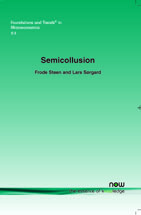Semicollusion
By Frode Steen, Department of Economics, Norwegian School of Economics and Business Administration, Norway, frode.steen@nhh.no | Lars Sørgard, Department of Economics, Norwegian School of Economics and Business Administration, Norway, lars.sorgard@nhh.no
Abstract
The notion 'semicollusion' refers to situations where firms collude in one (or several) choice variable(s) and compete in others. For example, firms collude on prices and compete on advertising. Although the notion 'semicollusion' is not so often used explicitly, it turns out that the topic is covered extensively in the economic literature. Moreover, the phenomena 'semicollusion' seem to be present in numerous industries. The purpose of this survey is to explain how semicollusion works in theory, describe empirical studies of semicollusion, and discuss the possible welfare effects of semicollusion.
Semicollusion
Collusion and competition are well known concepts in economic literature. The notion 'semicollusion' refers to situations where firms collude in one (or several) choice variable(s) and compete in others. Although the notion 'semicollusion' is not so often used explicitly, it turns out that the topic is covered extensively in the economic literature. Moreover, the phenomena 'semicollusion' seems to be present in numerous industries. The purpose of this volume is to explain how semicollusion works in theory, describe empirical studies of semicollusion, and discuss the possible welfare effects of semicollusion. Semicollusion distinguishes between collusion and semicollusion with examples of semicollusive behavior in particular industries. The volume provides a framework for understanding the mechanism at work with semicollusion and reviews the different approaches in the literature to this topic. Some of the literature assumes that firms collude on prices and compete on other variables such as advertising, capacities, or location. However, there is also another part of the literature where firms compete on prices and collude along other dimensions such as R & D. The authors discuss possible outcomes of semicollusion in industries with free entry. Semicollusion also reviews the empirical literature on semicollusion and the effects of semicollusion. There are empirical studies that cover various types of collusion, for example collusion on prices or collusion on R & D, and the authors discuss empirical studies for those outcomes that were covered in earlier chapters. The volume ends with a summary of the authors' findings, offers general conclusions, and discusses issues for future research.
